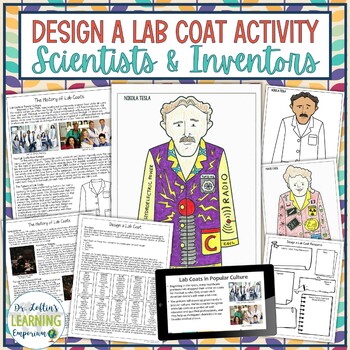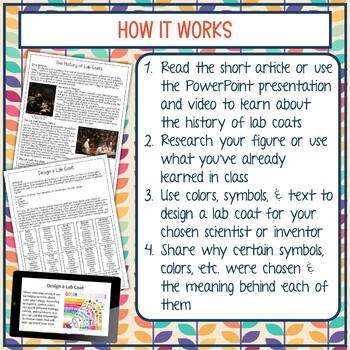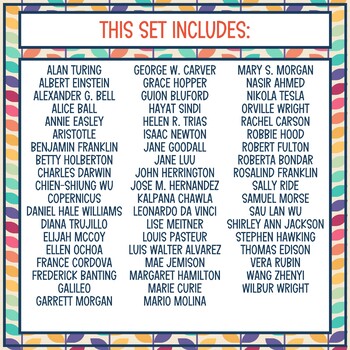Design a Lab Coat Activity No Prep Science Project - End of Year Activities
- Zip
What educators are saying
Description
Looking for a fun, no prep project that integrates science, art, and literacy AND keeps kids engaged? Your students will love designing a lab coat template for a famous historic or modern scientist, inventor, doctor, astronaut, engineer, or other STEM figure and it will quickly become one of *your* favorite activities too. Perfect as an end of year or after testing activity, students think critically and work independently as they apply their knowledge to design a lab coat for one of the 56 men and women in STEAM ... all while you cross things off your never ending to do list!
How It Works:
- Learn about the long history of lab coats using the 2-page article, by watching a short video, and/or using the included PowerPoint presentation
- Next, go over the directions for the assignment and learn about color psychology and the different design elements students will use for their lab coats. Go over the included examples so students know exactly what's expected of them.
- Students can brainstorm ideas and take notes using the research graphic organizer
- Students will use the included lab coat templates and colors, symbols, and text to design a custom lab coat for their assigned or chosen scientist or inventor
- Finally, they'll justify and explain their choices in a short writing assignment and/or class presentation.
Reasons You'll Love This Design a Lab Coat Activity:
- Engaging and fun activity that also requires critical thinking
- Multiple and flexible options for use with a reading, PowerPoint, video, and activity
- Integrates literacy, art, history, science, and more!
- Awesome for biography units
- Students can work independently or in groups
- Perfect for end of semester review or as a creative assessment
- Makes an awesome classroom, hallway, or bulletin board display
- Perfect for substitutes and filling multi-day gaps in your planned lessons
- Make it even more fun with a design competition
What's Included:
- Lab coat template for each person in black & white + color (see list below)
- 2-page article + 100% Editable PowerPoint about the history of lab coats
- Short video about why doctors wear white lab coats
- Student directions + Design tips
- Research graphic organizer + List of people to choose from
- Teacher Tips + Grading Rubric
- 3 Examples to share with students
- Blank lab coat templates for additional flexibility
Who's Included:
- Alan Turing
- Albert Einstein
- Alexander G. Bell
- Alice Ball
- Annie Easley
- Aristotle
- Benjamin Franklin
- Betty Holberton
- Charles Darwin
- Chien-Shiung Wu
- Copernicus
- Daniel Hale Williams
- Diana Trujillo
- Elijah McCoy
- Ellen Ochoa
- France Cordova
- Frederick Banting
- Galileo
- Garrett Morgan
- George W. Carver
- Grace Hopper
- Guion Bluford
- Hayat Sindi
- Helen R. Trias
- Isaac Newton
- Jane Goodall
- Jane Luu
- John Herrington
- Jose M. Hernandez
- Kalpana Chawla
- Leonardo Da Vinci
- Lise Meitner
- Louis Pasteur
- Luis Walter Alvarez
- Mae Jemison
- Margaret Hamilton
- Marie Curie
- Mario Molina
- Mary S. Morgan
- Nasir Ahmed
- Nikola Tesla
- Orville Wright
- Rachel Carson
- Robbie Hood
- Robert Fulton
- Roberta Bondar
- Rosalind Franklin
- Sally Ride
- Samuel Morse
- Sau Lan Wu
- Shirley Ann Jackson
- Stephen Hawking
- Thomas Edison
- Vera Rubin
- Wang Zhenyi
- Wilbur Wright
Frequently Asked Questions:
- Is there a digital version of this resource? I really tried to make it work digitally, but unfortunately I never found a solution that worked well. So I'm keeping it print for now!
- Does this resource include information about each person? Information about the individuals is not included. Students can use any source (textbook, video, website, etc.) to learn about their scientist or inventor
- Can this be adapted for younger grades? Absolutely! I recommend just using the PowerPoint as a class instead of relying on the 2-page article about the history of lab coats. Going over the included examples with students will be essential!
More Fun and Engaging Activities:
Scientists and Inventors Biography Graphic Organizers
National Parks Research Graphic Organizers
Who Was Biography Series Graphic Organizer Bundle
Ancient History Interactive Fan Bundle
U.S. Presidents Activity Bundle
Click here to follow me and be the first to hear about new products, sales, and special promotions. For additional resources, be sure to check out my store!
Katie Loftin





